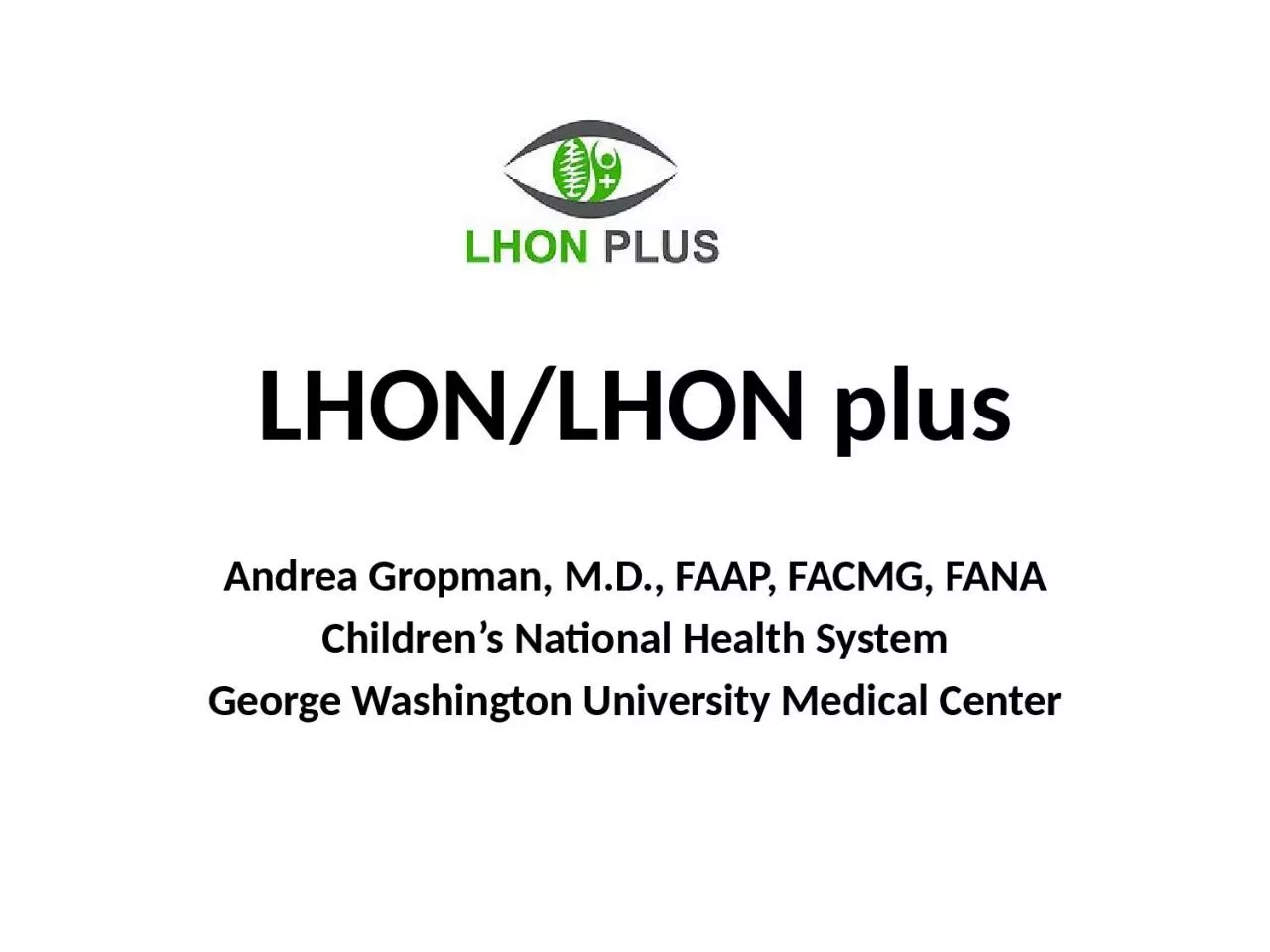

FAAP FACMG FANA Childrens National Health System George Washington University Medical Center LHON Lebers hereditary optic neuropathy or Leber hereditary optic atrophy M itochondrially ID: 931949
Download Presentation The PPT/PDF document "LHON/LHON plus Andrea Gropman, M.D" is the property of its rightful owner. Permission is granted to download and print the materials on this web site for personal, non-commercial use only, and to display it on your personal computer provided you do not modify the materials and that you retain all copyright notices contained in the materials. By downloading content from our website, you accept the terms of this agreement.
Slide1
LHON/LHON plus
Andrea Gropman, M.D., FAAP, FACMG, FANAChildren’s National Health SystemGeorge Washington University Medical Center
Slide2LHON
Leber's hereditary optic neuropathy or Leber hereditary optic atrophy Mitochondrially inherited degeneration of retinal ganglion cells and their axons Leads
to an acute or subacute loss of central
vision
Slide3LHON
Affects predominantly young adult males but is not X-linkedLHON is only transmitted through the motherDue to mutations in the mitochondrial genome, and only the egg contributes mitochondria to the embryo
Slide4LHON
Usually begins between ages 15-35 but can occur at any ageLeads to legal blindness59% prevalence rate of neurological abnormalities associated with LHON
Slide5Maternal inheritance
Slide6LHON
LHON: one of three pathogenic mutations11778 G to A3460 G to A 14484 T to CND4, ND1 and ND6 subunit genes of complex I of the oxidative phosphorylation chain in mitochondria
Slide7Slide8LHON plus
(other symptoms) Multiple sclerosis like symptomsEyeDouble visionOptic disc swellingVision loss
Slide9LHON plus
symptoms: other neurologicalMotor problemsStiff walkingSpasticity Bowel and bladder problems
Slide10Neurological
issuesMigraine headachesCognitive issuesNeuropathyi.e. Loss of vibration sensation (usually starts in the feet)
Seizures
Tremor
Slide11Neurological issues
Movement disordersTremorsDystonia (fixed postures)ParkinsonismSpeech issues
Slide12MRI findings
Small lesions, periventricular Same location of lesions as seen in Multiple sclerosis, MS
Slide13Slide14LHON Plus
MRI: deep gray matter lesions The basal ganglia are believed to be especially vulnerable to injury in mitochondrial disease due to high energy requirements and increased free radical formation
Slide15Slide16Slide17Slide18LHON plus: etiology
Progressive microangiopathyA disease of the capillaries (very small blood vessels), in which the capillary walls become so thick and weak that they bleed, leak protein, and slow the flow of blood
Slide19LHON plus: etiology
Optic nerve degeneration in LHON is due to disturbed mitochondrial function and a predominantly complex I respiratory chain defect has been identified However, the trigger for RGC loss is much more complex than a simple bioenergetic crisis
Slide20LHON plus: etiology
Other important disease mechanisms have emerged The downstream consequences of these mitochondrial disturbances are likely to be influenced by the local cellular milieu
Slide21LHON plus: etiology
The vulnerability of RGCs in LHON derive not only from tissue-specific, genetically-determined factorsincreased susceptibility to exogenous influences such as light exposure, smoking, and pharmacological agents with putative mitochondrial toxic effects
Slide22LHON Plus
Most cases with optic atrophy and dystonia have 11696G>A,14459G>A, or 14596T>A
Slide23LHON Plus
LHON “plus” disease with childhood onset has been described infrequentlyTo the best of our knowledge, few pediatric patients with the 11778GA LHON mutation have been reported with atypical Leigh-like
Slide24LHON plus
LHON plus is the name given to a rare variant of the syndrome with eye disease and other symptoms
Slide25LHON and LHON plus treatment
Management of affected individuals is largely supportive, with the provision of visual aids, help with occupational rehabilitation, and registration with the relevant social services
Slide26LHON and LHON plus treatment
ECG may reveal a pre-excitation syndrome in individuals harboring a mtDNA LHON-causing pathogenic variant; referral to cardiology can be considered and treatment for symptomatic individuals is the same as that in the general population
Slide27LHON and LHON plus treatment
Treatment for raised intraocular pressure in individuals who have a LHON-causing pathogenic variantAgents/circumstances to avoid: Individuals harboring a mtDNA LHON-causing pathogenic variant should be strongly advised to moderate their alcohol intake and not to smoke
Slide28LHON and LHON plus treatment
Avoid exposure to other putative environmental triggers for visual loss, in particular industrial toxins and drugs with mitochondrial-toxic effects